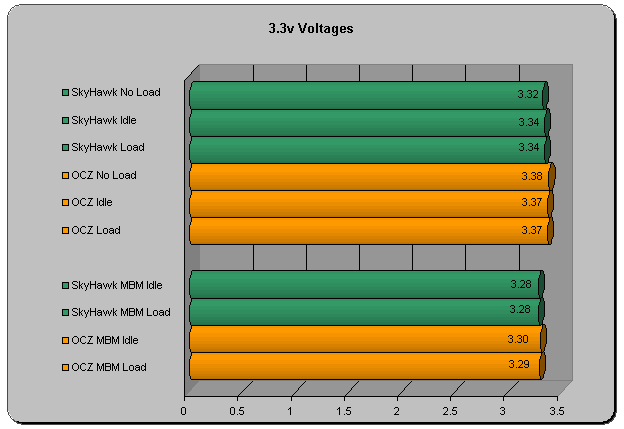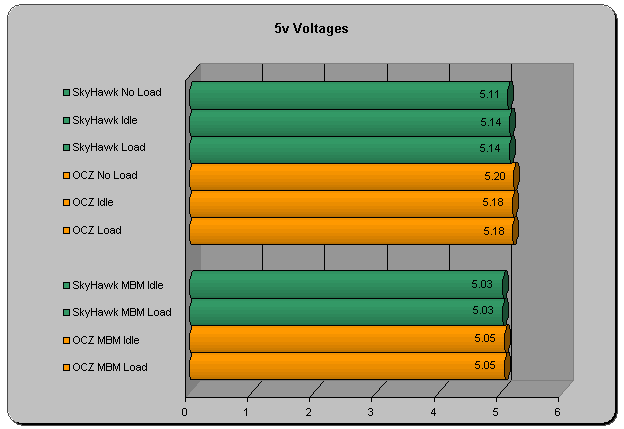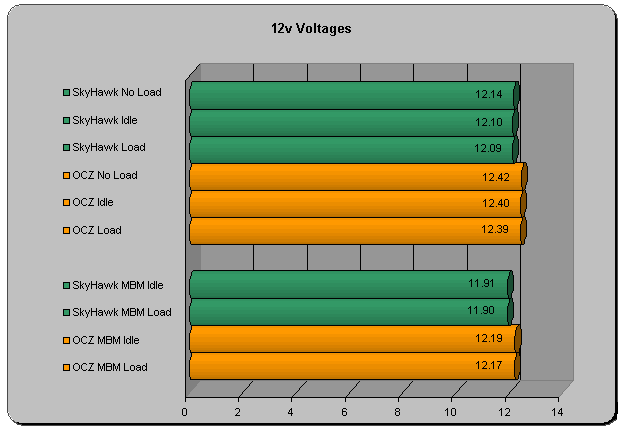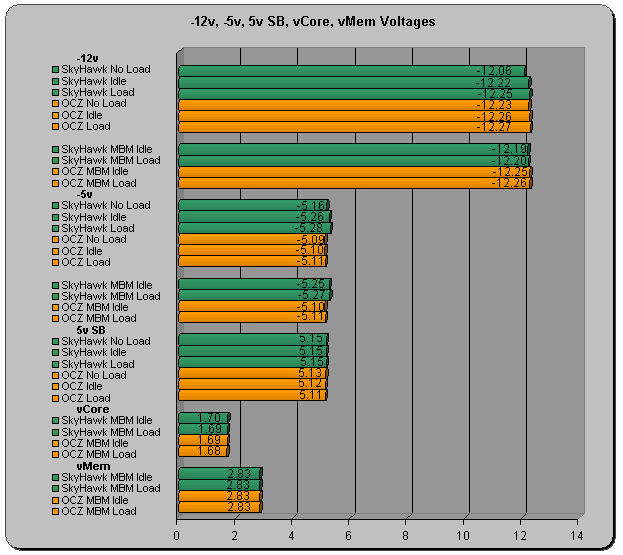SkyHawk PowerONE 620w Review **UPDATE 3/26**
Testing
I tested the SkyHawk PowerONE power supply on the following setup using a multimeter,
motherboard monitor, and my sound pressure level meter.
- Abit NF7-S rev. 2
- AMD 2500+ mobile @ 2.275ghz
- 512mb Kingmax PC4000
- Matrox G450 Video
- 2x 160GB Seagate SATA hard drives
- 120GB Western Digital hard drive
- Sony 8x DVD/RW
- 2x 120mm case fans
All voltages were taken from the ATX power connector and compared with voltages
reported from Motherboard Monitor 5. They were taken without load (no computer
connected), after the computer had idled for 30min, and again after 30min at
full load. Load was achieved by defragmenting the Western Digital hard drive
while rendering a 5min film in Vegas 4.0, and running folding@home in the background
to use any spare CPU cycles. Vegas loads the system by reading large video files
from a drive rendering a video effect frame by frame and then writing the frame
to the hard drive again, this particular sequence taxed my system at 97-99%
at all times, any remaining CPU time was used by F@H and the defrag utility.
**There have been no changes to my Socket A test bed and as such the
results from the OCZ
PowerStream tests are directly comparable with the new results from the
SkyHawk PowerONE**

The SkyHawk PowerONE proves quickly that it does not take $140 to get a solid
3.3v rail. The PowerONE exhibited almost no voltage fluctuation under all three
different test situations. The PowerONE’s voltages were also with in the
OCZ personal bubble only differing by at most .06v and at lest .03v. The SkyHawk
PowerONE also like the OCZ showed no change in voltage from idle to full load.

The PowerONE again demonstrates its stability and top quality voltage regulation.
The PowerONE again differs by only hundredths of a volt and shows no change
from idle to full load. It even beats the OCZ when going from no load to idle,
showing only a .03v increase in voltage to the OCZ .06v increase.

When it comes to SkyHawk’s 12v regulation we see one of the largest changes
and even that is still under a tenth of a volt, the change from no load to full
load is a mere .05v. Not as good as the OCZ but the OCZ PowerStream is only
.02v better. I can’t say I was excited to see under 12v in Motherboard
Monitor but the voltage drop is consistent with that of the OCZ, both drop around
two tenths of a volt when comparing the reading I took from the multimeter to
that registered by Motherboard Monitor.

Here in the final graph from testing the SkyHawk PowerONE shines. All of the
PowerONE’s voltages stayed well with in spec and were regulated very well
with only two exceptions, the -12v and -5v. On the -12v the PowerONE jumped
from -12.06v to -12.22v when I plugged in my computer and let it idle, while
no big deal it is a difference between the PowerONE and the OCZ which did not
have nearly as large a change. The same sort of thing happened on to the -5v
rail which went from -5.16v to -5.26 after I attached my computer and let it
idle. In both cases the change from idle to full load was minimal and inline
with the OCZ, all the while the vCore and vMem were rock solid. When you step
back from the picture the PowerONE is looking more and more like a decent quality
power supply.
When it comes to acoustics there are a few things to take into consideration.
First when the PowerONE is less than 40 degrees C then the fans are off. That’s
right no spinning motors, which means no noise. When the PowerONE is more than
40 degrees C then the fans start to spin up. I recorded the sound presure level
at less than 35dB when the fans were not spinning and around 36.5dB when they
were spinning. In the room I test in the SPL is always under 35dB which is the
threshold of my testing equipment. This means that the SkyHawk PowerONE is very,
very quiet even when the fans are spinning, so quiet in fact that I highly doubt
you will ever notice that the fans spun up when this is in a computer case.

Comments are closed.